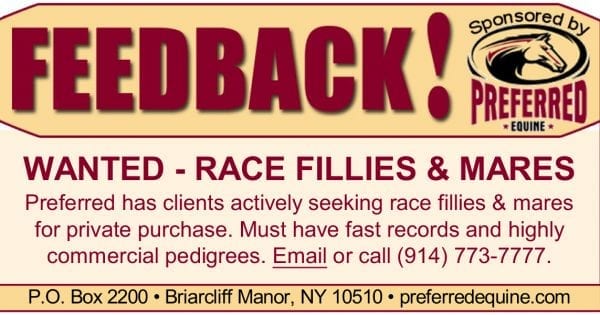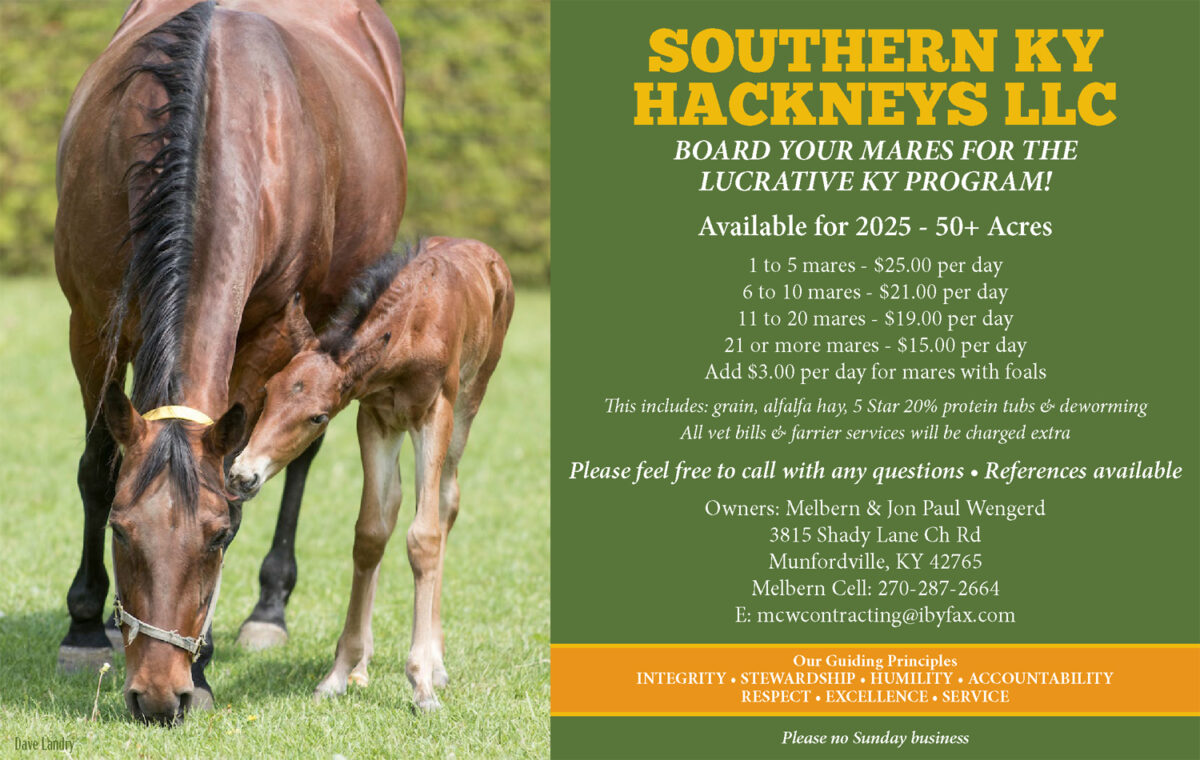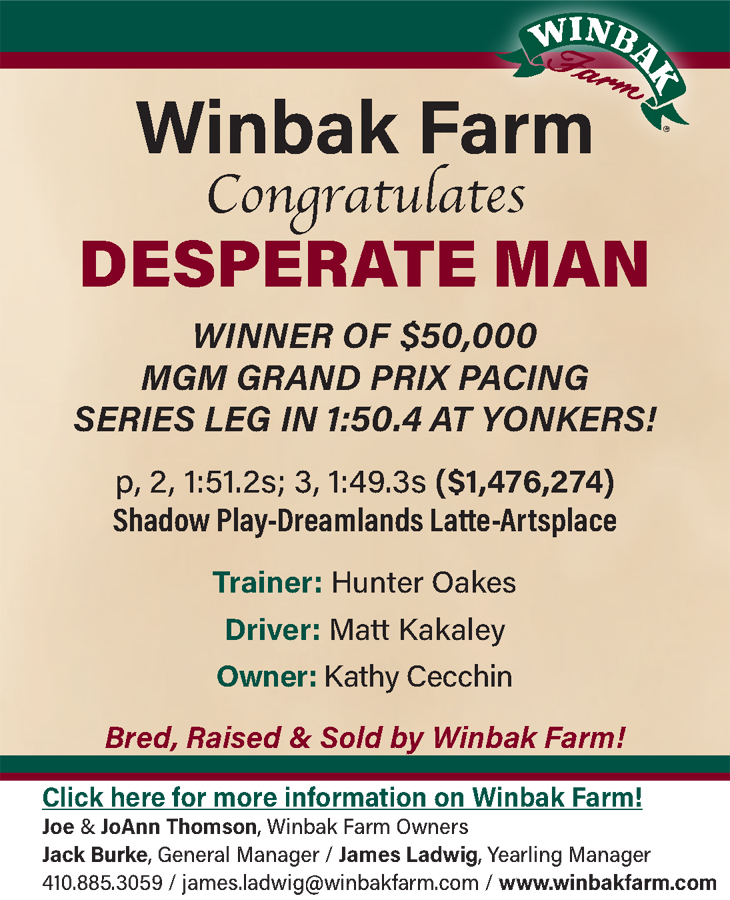HRU Feedback (2017-03-05)
The truth about harness racing data
As a follow up to Brett Sturman’s column entitled, Time to make electronic data free (full story here), I wanted to drill deeper into his dead on commentary.
I listened to the three hours of the USTA presidential debate (which was excellent), read most every post online and have talked to numerous bettors and breeders in the business. And with the exception of Brett’s column, harness racing data has been virtually absent from all discussions.
The keeper of your harness data is Trackmaster (owned by Equibase). Trackmaster has a long standing exclusive deal with USTA as the single and exclusive data provider. That means any and all decisions related to data, dynamic feeds or new technologies are at the sole discretion of this third party organization.
For that right, Trackmaster pays the USTA a sum of money. The “data licensing fee” can be found as a line item in the USTA financial statement, which is available for members but only upon request.
Although the USTA is a member-based, record-keeping organization, the data licensing fee goes to fund that institution.
I admire Trackmaster purely as a financial business. Their leadership has made brilliant business decisions over the years keeping the data exclusive for themselves. However, I am troubled by Trackmaster as an innovator and industry leader. Their refusal to explore strategic relationships with tech-forward thinkers is abhorrent. Ask anyone you know that’s ever had an idea for a harness racing aftermarket speed figure or data product and they will agree.
The power and revenue Trackmaster has gained was granted to them by the USTA. It was not earned via collaboration and nor out of a vision of growing of handle and technology. Look at overall handle and the inadequacy of cool data products like the thoroughbreds have with the Beyer Speed Figure, Rag Sheets and Thorograph.
Annual standardbred handle is about $1.5 billion, 15 per cent of thoroughbred handle. CRW services (computer robotic wagering groups) represent 35 per cent of total TB handle. Quick math tells you the total wagered by these player groups tops $3.5 billion.
CRW is not existent in standardbred pools. This lack of CRW participation and therefore lower handle costs owners and horsemen dearly.
The main reason behind the lack of CRW into your pools is the availability and quality of the harness racing data. While these groups have access to direct and dynamic data feeds that power their computer thoroughbred models, this technology is currently not available in harness racing.
Is CRW the ultimate for harness racing? No. But accessible data and tech forward thinking will bring us innovators who will create data technology tools that will spur handle.
Big data is taking over sports. The NBA just sold their exclusive data contract for $250 million to Sport Radar, the leader in sports data technology. If I had a startup sports data company (which I did), I could go to Sport Radar and get access to data for a minimal sum with few restrictions. Sport Radar has figured out by empowering smart people with their client data, they can grow interest and demand, which organically explodes their business. In less than five years, Sport Radar has cruised past Stats, Inc., historically the sports data industry bellwether (as a side note, Equibase and Stats developed a new product to compete with DRF Formulator called, Race Lens).
I had the opportunity to have dinner with former coach Mike Ditka a couple years ago in Las Vegas. He romanced us throughout the night with his stories until he was asked about the current state of the game.
His response was poignant, “the guys on the field are just the keepers of the game. They are responsible to pass it on to the next generation in better shape than they got it.”
I believe the same cannot be said for harness racing. Data has held this industry back, just look at a program from 30 years ago and one today.
Data and innovation needs to be front and center for the new USTA leader and as the next Trackmaster renewal comes about (in 2018 I believe), we as an industry need to make it loud and clear: We want our data back.
— Dan Zucker
RE: Marc Abramson’s letter
In Marc Abramson’s letter last week (2017-02-26 Feedback) there were some very good points to keep harness racing alive and well! I attend the races with a friend at least once a week (Dover Downs currently). Her aunt is also usually there. She has a lot of questions; many that I cannot answer even though I have attended live harness racing since I was eight years old (quite a few years).
Please fill some of that dead, boring time between races, and that extra seven minutes between post time and actual post time and answer these questions. This doesn’t have to put extra work on the announcer. The PR people can take over. They could also show previous races of horses who are racing in the upcoming featured races: the opens, preferred, etc. Also, give free rides in the starting car; free tours of the paddock. The Meadowlands does this. People want to see behind the scenes.
— Lorraine@Horse Lovers United Inc
Random thoughts
I have thought about writing an open letter for quite some time, but why bother? But maybe our industry is ready to act. Before we can market our sport we should first attempt to fix it. Marketing something that is less than par would be a waste of time, money and effort. Where to start? Well it starts with strong leadership. Football, basketball, NASCAR, and Mixed Martial Arts all come to mind as sports with strong leadership. Horse racing and Boxing have had no leadership and both have suffered the most because of it. Both sports have also had too many bad actors and the public got tired of the cheating, drugging, and little recognition of the stars. On top of that, the press does not publish much about either sport, and what is published, is too often negative.
The Gural rule: Harness racing has a lot to fix and the Gural rule (by itself) will do little. To those who said it failed please tell me what the expectations were. Was this rule supposed to make everyone whole? No, it was one man’s attempt to keep potential stars in front of the public. Trying it for two years while many were undermining it from the beginning got us nowhere.
Takeouts, are they too high? In Pennsylvania the takeout on trifectas is 35 per cent. Last Tuesday (Feb. 20) The Meadows ran a 13-race card. If the tri pool in race #1 started with $100,000 and no “new” money was added after race #1 there would be $65,000 left to wager on race #2. After race #2 there would be $42,250. After race #13 there would be $370 left. That’s right, the takeout would have taken $99,630. Um, are the takeouts too high? Using a 25 per cent takeout rate would leave $2,376 after 13 races. How can this appeal to anyone with half a brain? As a side note, the 13-race card that day produced 10 favorites winning and six of the 10 were odds on. The three non-favorites that won went off at 2.8, 5.1 and 6.7 to 1. There were 103 horses competing that day with 34 of those being irrelevant as far as the wagering public was concerned (or 33 per cent of the total). Of those 34 irrelevant horses, three finished third and four finished fourth. Of the 13 most outside horses (in the 13 races) two of them managed to finish third.
Post time drag. Having a countdown clock and sticking to it makes a lot of sense to me. Having a clock that reads zero for who knows how long is no way to run a railroad. If delaying each race by five or more minutes creates bigger handle, why stop there? Delay every race by an hour. What creates larger handle is bigger field size (with relevant wagering interests), pools with “real” critical mass, ease of wagering from home or office, broadcasting the product in HD, but first we need a product. Small track racing is not a way to win new patrons, or for that matter a way to keep old ones.
Tote board. What is up with 3-5, 7-2, or my favorite 1-9, which really means 1-10 or 1-20 but no one really knows till after the race. Post all odds as decimal to 1 so someone new can understand it without taking fourth grade arithmetic all over again. Speaking of tote, why do we have more than one tote company with their 1960s technology? We have one electric company and one cable company. Redundancy is too expensive and non-efficient.
Exchange wagering on Betfair, how is that working NJ? You can’t take a 12 per cent cut. If it ever had a chance to help it was doomed before it was ever launched. I wish the guy who thought up the 12 per cent had to play his own money for a week.
Does the USTA need 60 directors? 59 is just not enough? Why do we time races in 1/5 second increments? Why does bottled water cost more than beer at the racetrack? Why did Balmoral racetrack have a surcharge (on wagering) on their on-track patrons? Do the people who profit from food sales ever taste the stuff they sell? Why are the golf pencils free at the golf course but cost $.50 at the racetrack? Why does the hotel give its patrons the WSJ for free and a racing form costs $4.50? Why do we take wagers for ten cents? Why do the people that make the morning line not understand that the odds must add up to 100 plus takeout? Why does the racetrack say “when can you get here” when I ask what time is first post?
Horseracing is the only business I know of where the high bidder wins. We have a business model that never thinks to discount for volume. Our drivers and trainers work for the same 5 per cent for a $5,000 race or a $500,000 race. The auctioneers and consigners take the same 10 per cent on a $5,000 sale or a $500,000 sale. The racetrack takes its 20 per cent on a $0.10 wager or a $1,000,000 wager. Discounts drive traffic. Walmart, Costco, Amazon, Southwest Airlines, and Las Vegas are just a few of the success stories built on discounts. Rebates at the betting window could do wonders.
I realize I only scratched the surface.
Mr. Sam McKee, please hurry back, we need you more than ever.
Mr. Towers is so correct about “staying relevant”. Take notice everyone!
— Dana Parham / Fort Lauderdale, FL
The importance of being earnest and relevant
A quick note about the article on the sport needing to be relevant and to some of the response to said article (full story here):
“We need to attract the 18-30 year old crowd.”
“Gotta get new blood to replace the old.”
“Let’s make it something other than your grandpa’s game.” Or other, similar, comments.
I’ve been listening to them for the last 25 years.
Here’s the question: How is the new marketing campaign geared toward the millenials working out?
I don’t see them showing up and betting at my local track. I do see them going into the nightclub to drink and to fly into a testosterone induced rage over females, hence the need for the State Police to be nearby.
I hear the (adult) kids of my friends when they come out for a night of racing. “This is REALLY slow.” This is the most common.
“I’m bored.” There’s another one.
“Casino is better and I can get drinks.” Heard this one many times.
Does anyone remember the tremendously annoying ad campaign in the ‘90s on the thoroughbred side, “Go baby, Go?” with the annoying, waif thin girl who looked like she could have been in “Breaking Bad?”
How many did that attract?
I bet they didn’t even get their money out for what the ads cost them. A definite loss there.
Marketing isn’t the answer. You can’t make people play a game they are simply not interested in.
This is the same sort of problem jazz music has always had.
People aren’t really exposed to it and they aren’t because they don’t understand or like it.
Want to clear out a roomful of people fast? Put on 10 minutes of John Coltrane or Miles Davis and watch the people scatter.
They simply don’t like it, nor did they/we ever like it. It was always a specialized audience, and a very small one at that.
Sort of like harness racing today.
How many people show up at Yonkers, or Pocono, or Cal Expo, or Pompano or Saratoga for the live racing? And why is that?
It has nothing to do with demographics at this point, and everything to do with the oversaturation of the gambling market, plain and simple.
Close the casinos and the lotteries and harness becomes relevant again.
Disconnect online poker and online gaming and watch the handle once again increase.
There’s the answer.
The next question is how to get these younger people either online or to the track to bet these races?
Maybe it’s the linking with some races to some sort of casino/lottery jackpot? A sweepstakes sort of thing. Your horse wins a race and you get entered into a contest or pool connected to a lottery game for a big prize. Something like that.
Anything else leaves the people who are looking for new blood merely chasing their tails.
I been watching this for a long time.
— Vic Dante / North Caldwell, NJ
We are a gambling product
In the last few weeks, there has been increased discussion online regarding the problems facing the harness racing industry and how best to combat those issues. Good conversations have been sparked by the USTA Presidential Debate, a recent Pickinsider.com article by Megan Maccario (full story here), Harness Racing Update and others. Much of the back and forth has centered on getting more people to the racetrack, increasing awareness with the public and cultivating new owners. While I am glad to see people within the industry actively involved in seeking solutions to our problems, unfortunately, any of these discussions could have (and in fact have) taken place at any time in the past 25 or 30 years.
The harness racing industry will not long survive if the powers that be continue to ignore one simple fact: We are a gambling product, period. Sadly, we are a gambling product that has become stale, hugely overpriced and is not seen by the public as particularly trustworthy. To ignore this truth and focus on how to get more non-gamblers out to the racetrack is the equivalent of treating one’s lung cancer by taking cough syrup. You may cough less for a short time before you eventually die, but without addressing the underlying cancer, you have no chance for survival.
To be clear, I have a background that includes several years working in marketing and promotions in minor league baseball. I could not agree more with those who argue that racetracks need to do much better in attracting new people to the races and in providing an enjoyable experience, which will encourage those in attendance to return again and again. I also firmly believe that this is not solely a track function and that those of us involved on the racing side need to be involved in these efforts. The more people we can expose to harness racing, the more likely we are to create new potential fans. However, our survival is dependent on creating new potential wagering customers, not simply fans or attendees who show up for promotions unrelated to the racing itself.
For basically the entire second half of the 20th century, horse racing had a monopoly on legalized wagering in most jurisdictions. Now, legalized gambling is everywhere. Competition for the wagering dollar is fierce, and our industry has done nothing to compete for market share against those new products that have entered the marketplace.
We all long for the days of huge crowds at the racetrack every night, but, realistically, those days are gone with the exception of a few big events. Despite the nostalgic notion that the crowds were there because of the love of the horse, or the sport itself, it is decades beyond time to recognize that the crowds were there to gamble. In the modern era, there are virtually unlimited alternative options to do so. We must improve our product substantially and immediately, or we will surely see the industry continue to fade away.
The changes that need to happen on the wagering front are not hard to delineate, nor are these suggestions in any way new or original. They have been discussed and debated (and ultimately ignored) for years. At the end of the day, nothing has changed and the industry has continued to decline. It is time to face reality and focus on improving our product to be competitive in a very difficult market.
These things need to happen right away:
• Takeout (the price of our product) must be reduced to a completive level. Blended takeout (currently well over 20% in most jurisdictions) needs to be no higher than 12% with a target of 10%.
• Hong Kong levels of integrity must be implemented across the board. Testing needs to be the best in the world, with out-of-competition testing a major focus. Those who violate the rules need to be dealt with swiftly and severely. No more transferring horses to a new paper trainer. Penalties in serious cases must follow the horse and the owner(s). If we can’t provide a gambling product the public trusts, we have no chance to be competitive in the gambling market.
• A professional, industry wide marketing program needs to be implemented. Funding for this effort should come from a small percentage of purses paid out at all tracks. This marketing program should focus not only on getting people to the track to gamble, but also on our one remaining advantage in the current gambling market – the ability to wager online.
• Programs must be freely available online for all pari-mutuel tracks. Charging for the information our customers need to wager is as absurd as the idea of a casino charging a blackjack player for use of the cards.
• Every pari-mutuel race in the United States should be streamed live on the USTA website at no cost to the viewer. All replays should also be accessible in this fashion.
This list is by no means an exhaustive fix, as the many good ideas for marketing the product being discussed online and elsewhere need to be refined and explored. Educational programs for teaching new bettors how to wager need to be vastly expanded. We need to find better ways to expose the public to our best asset, the horse. All that said, it is time to change the conversation and focus on cultivating new gambling customers. The above list of items is years – in many cases two decades – overdue. If we are going to turn this industry around, handle on our races must significantly increase in the next five years to a base level that can support racing without slots welfare. It is simply a matter of time before legislatures around the county find other uses for slot revenue currently being diverted to racing. If that happens before our industry has taken serious steps to become a competitive gambling product, harness racing as we know it will inevitably become a thing of the past.
— Josh Carter / Williamsville, IL
Solving one of our problems
Our sport has problems, as all sports do, and hopefully we can solve those problems and make our sport better. Let me address one issue that is a major nuisance and makes most of us quite uncomfortable – “0 Minutes To Post”. We all know what an ongoing embarrassment to harness racing that is. I have a solution: eliminate it.
That’s right, “0 Minutes To Post” doesn’t even make sense. “0 Minutes To Post” should mean that it is now post time, which it obviously isn’t, otherwise you would just say: it’s post time. Who says they are going to do something in zero minutes? Nobody ever does and we shouldn’t either! Here is what I propose: When the clock gets to 1 minute and the minute is up, it should remain at 1 minute for an additional 60 seconds. At that point it should be replaced by a post time status update. For example, “The Starting Gate Is In Position”. When the horses are called to the gate the countdown clock begins, 30, 29, 28, you get the idea. How often do you get a chance to make a simple change that will greatly improve our sport. I will be contacting tracks to try to get this implemented, and I hope that when the big races start in a few months “0 Minutes To Post” will be an unsightly anachronism we have put behind us forever.
— Mel Cheplowitz / San Rafael, CA
I wonder why….
I wonder why, while listening to WFAN on my iPhone, I heard Ken Warkentin advertising for the (doo wop group) The Belmonts at Victory. Was Lawrence Welk not available? That does not seem like a very good way to draw those much talked about young people to the track.
I wonder why the Meadowlands offers seniors a coupon good for a $1 dollar hot dog, coffee, or donut, while TVG regularly sends money back 20 dollar wagers for pari-mutuel wagering and 25 dollar money back for exchange wagering. At least the track could give a free coffee to a senior instead of charging a damn dollar.
I wonder why a trainer named Nick at Freehold Raceway with over 100 starts has a 50 per cent win percentage.
— David Haaker / Livingston, NJ

















